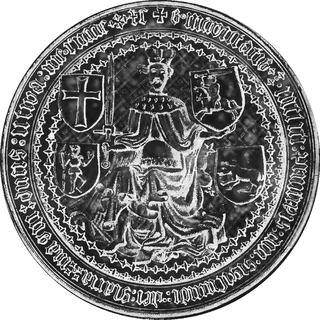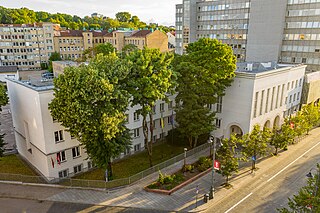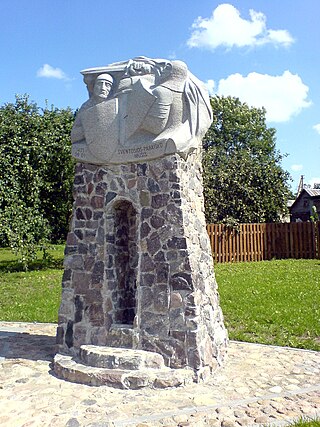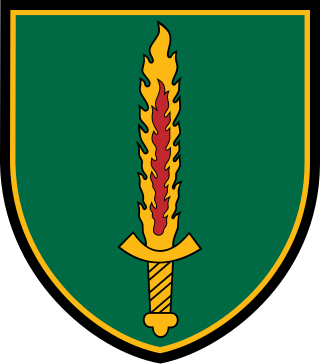
Jogaila, later Władysław II Jagiełło, was Grand Duke of Lithuania, later giving the position to his cousin Vytautas in exchange for the title of Supreme Duke of Lithuania (1401–1434) and then King of Poland (1386–1434), first alongside his wife Jadwiga until 1399, and then sole ruler of Poland. Born a pagan, he converted to Catholicism in 1386 and was baptized as Ladislaus in Kraków, married the young Queen Jadwiga, and was crowned King of Poland as Władysław II Jagiełło. In 1387, he converted Lithuania to Catholicism. His own reign in Poland started in 1399, upon the death of Queen Jadwiga, lasted a further thirty-five years, and laid the foundation for the centuries-long Polish–Lithuanian union. He was a member of the Jagiellonian dynasty in Poland that bears his name and was previously also known as the Gediminid dynasty in the Grand Duchy of Lithuania. The dynasty ruled both states until 1572, and became one of the most influential dynasties in late medieval and early modern Europe.

Vytautas Landsbergis is a Lithuanian politician and former Member of the European Parliament. He was the first Speaker of Reconstituent Seimas of Lithuania after its independence declaration from the Soviet Union. He has written 20 books on a variety of topics, including a biography of Mikalojus Konstantinas Čiurlionis, as well as works on politics and music. He is a founding signatory of the Prague Declaration, and a member of the international advisory council of the Victims of Communism Memorial Foundation.

Vytautas, also known as Vytautas the Great from the late 14th century onwards, was a ruler of the Grand Duchy of Lithuania. He was also the prince of Grodno (1370–1382), prince of Lutsk (1387–1389), and the postulated king of the Hussites.

Vytautas Magnus University (VMU) is a public university in Kaunas, Lithuania. The university was founded in 1922 during the interwar period as an alternate national university.

Švitrigaila was the Grand Duke of Lithuania from 1430 to 1432. He spent most of his life in largely unsuccessful dynastic struggles against his cousins Vytautas and Sigismund Kęstutaitis.

The Battle of the Vorskla River was fought on August 12, 1399, between the Tatars of the Golden Horde, under Edigu and Temür Qutlugh, and the armies of Tokhtamysh and a large Crusader force led by Grand Duke Vytautas of Lithuania. The battle ended in a decisive Tatar victory for the Golden Horde.

Skirgaila was a regent of the Grand Duchy of Lithuania for his brother Jogaila from 1386 to 1392. He was the son of Algirdas, Grand Duke of Lithuania, and his second wife Uliana of Tver.

Sigismund Kęstutaitis was the Grand Duke of Lithuania from 1432 to 1440. Sigismund was his baptismal name, while his pagan Lithuanian birth name is unknown. He was the son of the Grand Duke of Lithuania Kęstutis and his wife Birutė.

Birštonas is a balneological resort and a spa town in Lithuania situated 30 km (19 mi) south of Kaunas on the right bank of the Nemunas River. Birštonas received its city rights 1529 and was appointed a city in 1966. The city is the administrative centre of the Birštonas municipality.

The Treaty of Melno or Treaty of Lake Melno was a peace treaty ending the Gollub War. It was signed on 27 September 1422, between the Teutonic Knights and an alliance of the Kingdom of Poland and the Grand Duchy of Lithuania at Lake Melno, east of Graudenz (Grudziądz). The treaty resolved territorial disputes between the Knights and Lithuania regarding Lithuania Minor and Samogitia, which had dragged on since 1382, and determined the Prussian–Lithuanian border, which afterwards remained unchanged for about 500 years. A portion of the original border survives as a portion of the modern border between the Republic of Lithuania and Kaliningrad Oblast, Russia, making it one of the oldest and most stable borders in Europe.
Awards and decorations of Lithuania are governed by the Republic of Lithuania Law on State Awards of 2002, amended in 2003.

The Order of Vytautas the Great is the Lithuanian Presidential Award. It may be conferred on the heads of Lithuania and foreign states, as well as their citizens, for distinguished services to the State of Lithuania.

Constitutional Court of the Republic of Lithuania is the constitutional court of the Republic of Lithuania, established by the Constitution of the Republic of Lithuania of 1992. It began the activities after the adoption of the Law of Constitutional Court of the Republic of Lithuania on 3 February 1993. Since its inception, the court has been located in Vilnius.

The Lithuanian Civil War of 1432–1438 was a war of succession to the throne of the Grand Duchy of Lithuania, after Vytautas the Great died in 1430 without leaving an heir. The war was fought on the one side by Švitrigaila, allied with the Teutonic Knights, and on the other by Sigismund Kęstutaitis, backed by the Kingdom of Poland. The war threatened to sever the Union of Krewo, the personal union between Poland and Lithuania. Švitrigaila's alliance with the Grand Master of the Teutonic Order, Paul von Rusdorf, launched the Polish–Teutonic War (1431–1435) but failed to secure victory for Švitrigaila.

The Lithuanian Civil War of 1389–1392 was the second civil conflict between Jogaila, King of Poland and Grand Duke of Lithuania, and his cousin Vytautas. At issue was control of the Grand Duchy of Lithuania, then the largest state in Europe. Jogaila had been crowned King of Poland in 1386; he installed his brother Skirgaila as ruler of Lithuania. Skirgaila proved unpopular and Vytautas attempted to depose him. When his first attempt to take the capital city of Vilnius failed, Vytautas forged an alliance with the Teutonic Knights, their common enemy – just as both cousins had done during the Lithuanian Civil War between 1381 and 1384. Vytautas and the Knights unsuccessfully besieged Vilnius in 1390. Over the next two years it became clear that neither side could achieve a quick victory, and Jogaila proposed a compromise: Vytautas would become Grand Duke and Jogaila would remain Superior Duke. This proposal was formalized in the Ostrów Agreement of 1392, and Vytautas turned against the Knights. He went on to reign as Grand Duke of Lithuania for 38 years, and the cousins remained at peace.

The Lithuanian Civil War of 1381–1384 was the first struggle for power between the cousins Jogaila, Grand Duke of Lithuania and later King of Poland, and Vytautas the Great. It began after Jogaila signed the Treaty of Dovydiškės with the Teutonic Knights which was aimed against his uncle Kęstutis, father of Vytautas. Kęstutis briefly seized power in the Grand Duchy, but was betrayed by adherents of Jogaila primarily from Vilnius. During negotiations for a truce Kęstutis and Vytautas were arrested and transported to the Kreva Castle. Kęstutis died there a week later but Vytautas managed to escape and then sought an alliance with the Teutonic Knights. Subsequently their joint forces raided Lithuanian lands. Eventually the cousins were reconciled as Jogaila needed internal stability in anticipation of negotiations with the Grand Duchy of Moscow and the Kingdom of Poland regarding the possible Christianization of Lithuania. The war did not settle the power struggle; it continued during the next Lithuanian Civil War (1389–1392) which was resolved by the signing of the Ostrów Agreement. After more than ten years of struggle, Vytautas finally became the Grand Duke of Lithuania and ruled the country for thirty-eight years.

Samogitian uprisings refer to two uprisings by the Samogitians against the Teutonic Knights in 1401–1404 and 1409. Samogitia was granted to the Teutonic Knights by Vytautas the Great, Grand Duke of Lithuania, several times in order to enlist Knights' support for his other military affairs. The local population resisted Teutonic rule and asked Vytautas to protect them. The first uprising was unsuccessful and Vytautas had to reconfirm his previous promises to transfer Samogitia in the Peace of Raciąż. The second uprising provoked the Knights to declare war on Poland. Hostilities escalated and resulted in the Battle of Grunwald (1410), one of the biggest battles of medieval Europe. The Knights were soundly defeated by the joint Polish–Lithuanian forces, but Vytautas and Jogaila, King of Poland, were unable to capitalize on their victory. Conflicts regarding Samogitia, both diplomatic and military, dragged until the Treaty of Melno (1422).

The Lithuanian Special Operations Forces (LITHSOF) (Lithuanian: Lietuvos Specialiųjų Operacijų Pajėgos) is a special operation unit of the Lithuanian Armed Forces, formed exclusively of carefully selected, motivated and specially trained professionals. The main tasks of the Special Operations Force are direct action, special reconnaissance, and military assistance.

BC Prienai was a Lithuanian professional basketball club based in Prienai. They played domestically in the Lithuanian Basketball League every year since winning the promotion in 2009. During the 2008–09 season, then called Rūdupis, they became the champion of the NKL and won the challenge match for a slot in the LKL. In their debut LKL season Rūdupis took seventh place, while next two seasons brought BC Prienai two bronze LKL medals. BC Prienai played in EuroCup 2011–12 with moderate success; the team won 3 games out of 6, but nonetheless failed to qualify for the next stage. More recently, the team has become a strong competitor in domestic tournaments, more than once upsetting teams such as Žalgiris Kaunas and Lietuvos rytas Vilnius. In December 2017, in a highly publicized move, Vytautas signed American basketball players and brothers LaMelo and LiAngelo Ball.

Gabrielius Landsbergis is a Lithuanian politician, Minister of Foreign Affairs in the 18th Government of the Republic of Lithuania led by the Prime Minister Ingrida Šimonytė. He is a Member of the Seimas for Centras – Žaliakalnis constituency, and a former member of the European Parliament. He was a member of Group of the European People's Party. Landsbergis was elected as the Chairman of the Homeland Union in 2015. He is credited with modernising the Homeland Union.